Giraffe
- Lisbeth
- Site Admin
- Posts: 67384
- Joined: Sat May 19, 2012 12:31 pm
- Country: Switzerland
- Location: Lugano
- Contact:
Re: Giraffe
Giraffe survives despite deformed jaw
Posted on 8 May, 2018 by Guest Blogge in Animal Encounters, Wildlife
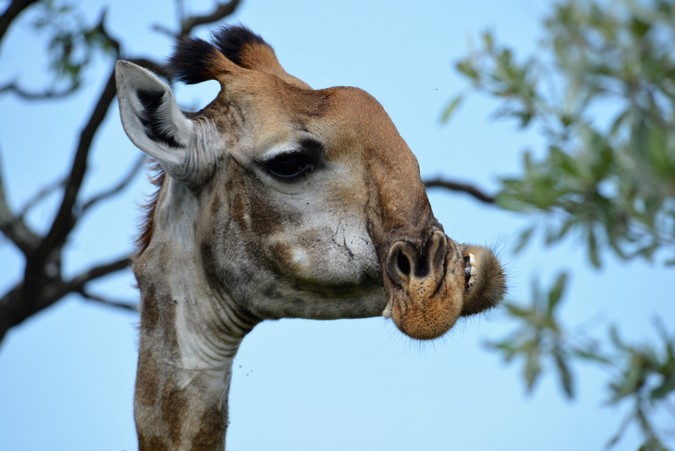
© Nikita Loreggian
Written, and photographs, by Nikita Loreggian
This giraffe cow, with a noticeably deformed jaw, was spotted last month on the Pretoriuskop road in the Kruger National Park, South Africa. She was with her herd and clearly in very good health – she was even able to eat despite her deformed jaw.
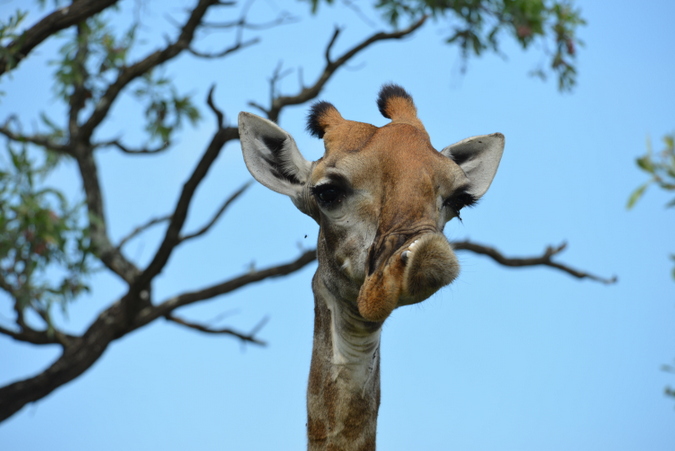
This is not a common sighting in the Kruger National Park, but there are a few of those who have seen this giraffe before. The same giraffe was spotted by someone in back in 2009, and then there was another report of seeing her in 2013.
It is wonderful to see how long this giraffe has been around in the park and that she has been able to adapt to her condition.

Posted on 8 May, 2018 by Guest Blogge in Animal Encounters, Wildlife

© Nikita Loreggian
Written, and photographs, by Nikita Loreggian
This giraffe cow, with a noticeably deformed jaw, was spotted last month on the Pretoriuskop road in the Kruger National Park, South Africa. She was with her herd and clearly in very good health – she was even able to eat despite her deformed jaw.

This is not a common sighting in the Kruger National Park, but there are a few of those who have seen this giraffe before. The same giraffe was spotted by someone in back in 2009, and then there was another report of seeing her in 2013.
It is wonderful to see how long this giraffe has been around in the park and that she has been able to adapt to her condition.

"Education is the most powerful weapon which you can use to change the world." Nelson Mandela
The desire for equality must never exceed the demands of knowledge
The desire for equality must never exceed the demands of knowledge
- Richprins
- Committee Member
- Posts: 75960
- Joined: Sat May 19, 2012 3:52 pm
- Location: NELSPRUIT
- Contact:
Re: Giraffe
Remarkable! 
Please check Needs Attention pre-booking: https://africawild-forum.com/viewtopic.php?f=322&t=596
- Lisbeth
- Site Admin
- Posts: 67384
- Joined: Sat May 19, 2012 12:31 pm
- Country: Switzerland
- Location: Lugano
- Contact:
Re: Giraffe
Giraffes - The silent Extinction
THE GIRAFFES OF AFRICA – THE LONG AND SHORT OF IT
by
Simon Espley & Giraffe Conservation Foundation
Thursday, 21 June 2018

It’s hard to comprehend that giraffe numbers have plummeted by almost 40% in just three decades. This rapid slide now places them amongst the most threatened species on the planet, with only approximately 98,445 individuals remaining across this massive African continent!
A population collapse of this nature could conceivably be driven by that evil Far East cabal of wildlife traffickers that perpetuate myths about how wild animal parts can improve health, wealth and happiness. In this case though, it would appear that the now familiar threats of habitat loss, degradation and fragmentation coupled with human population growth and illegal hunting (poaching) are to blame.
I would imagine that its large size makes it difficult for giraffes to pass through dangerous human-occupied territory unnoticed, and surely the return for the effort of killing a giraffe is high, what with all of that meat on the hoof.
“We do not have any evidence of giraffe in traditional Chinese medicine, but in all honesty a detailed trade assessment is required to better understand local and/or potential international trade. At this stage, we are aware of the bushmeat trade in different countries and the interest in tails as fly swatters (dowry for brides) in northern Kenya and DRC.” – Dr. Julian Fennessy, Giraffe Conservation Foundation (GCF)
Angolan giraffe (G. g. angolensis) © Giraffe Conservation Foundation
Here then, is a summary of what you need to know about the giraffes of Africa, with information provided by the Giraffe Conservation Foundation (GCF). This is the long and the short of it.
CONSERVATION STATUS
Giraffes, as a species, are listed as ‘Vulnerable’ according to IUCN, which means that they are vulnerable to extinction in the near future. Updates for most of the currently recognised subspecies are under review by IUCN, with updated status assessments expected soon, in mid-2018.
There has been limited conservation effort and research on giraffes across Africa, and so, to aid conservation efforts going forward, GCF has compiled historical and current data on giraffe numbers, distribution and threats from across their range in Africa. This work has been undertaken collaboratively with African governments, NGOs, universities, IUCN and independent researchers.

Young South African giraffe (G. g. giraffa) suckling in Botswana’s Okavango Delta © Julian Fennessy, Giraffe Conservation Foundation
GIRAFFE SPECIES
There are four distinct giraffe species in Africa, and two of these species have two and three subspecies respectively. All live in geographically distinct areas across Africa and do not cross-breed in the wild (they have been known to do so in zoos).
• Download Africa’s Giraffe – species (PDF) and Africa’s Giraffe – spot pattern (PDF)
Masai giraffe (Giraffa tippelskirchi)
The Masai giraffe is often noticeably darker than other species. Its blotches are large, dark brown and distinctively vine leaf-shaped with jagged edges, separated by irregular, creamy brown lines.
It ranges through central and southern Kenya and throughout Tanzania, with a geographically isolated population (potentially subspecies) in the South Luangwa Valley in Zambia. This Zambian population was previously mistakenly assumed to be Thornicroft’s giraffe, but they are genetically identical to the Masai giraffe. A small number have been translocated into Akagera National Park in Rwanda – outside of their natural range. Historically the most populous of the species, recent reports of poaching suggest that their population is decreasing. The population estimate is 32,500 individuals.
Masai giraffe (Giraffa tippelskirchi) © Billy Dodson
Reticulated giraffe (Giraffa reticulata)
The reticulated (or Somali) giraffe has brown-orange patches which are clearly defined by a network of thick and striking white lines. This species is found predominantly in central, north and northeastern Kenya, with small populations and range persisting in southern Somalia and southern Ethiopia. It has been estimated that about 8,700 individuals remain in the wild (likely more with new counts being undertaken) – down from an approximate 31,000 as recently as 1998.
Southern giraffe (Giraffa giraffa)
The southern giraffe has two subspecies:
1. Angolan giraffe (G. g. angolensis)
The Angolan giraffe’s pattern extends all the way down the legs and is made up of large, uneven and notched spots against a white (or cream) to tan-coloured background. This subspecies is found in most parts of Namibia, central Botswana and Zimbabwe. They went locally extinct in Angola until recent private translocations. Some have been translocated into DRC, South Africa, Zimbabwe, Nigeria and other parts of Botswana – outside of their natural range. The population is estimated at 13,050 individuals.


Angolan giraffes (G. g. angolensis) in Damaraland, northwest Namibia; Both photos © Julian Fennessy, Giraffe Conservation Foundation
2. South African giraffe (G. g. giraffa)
The South African (or Cape) giraffe’s pattern extends all the way down the legs and is made up of large, uneven and notched spots on a background that is more tan-coloured than white or cream. This subspecies is found across South Africa, Botswana, northeastern Namibia, southwestern Zambia and some areas in Zimbabwe, with conservation re-introduction efforts into Mozambique. Previous extralimital introductions of this subspecies and of Angolan giraffe into their known range are likely to have resulted in hybrid populations in those areas.
There have also been introductions of South African giraffe beyond their natural range, in South Africa, Angola, Senegal, Swaziland and Zambia. The population is estimated at more than 39,000, making this the most populous species.
Nubian giraffe (G. c. camelopardalis) herd in Murchison Falls National Park, Uganda © Julian Fennessy, Giraffe Conservation Foundation
Northern giraffe (Giraffa camelopardalis)
The northern giraffe has three subspecies:
1. Kordofan giraffe (G. c. antiquorum)
The Kordofan giraffe’s spots are pale, large and rectangular. It has no markings below the hocks. This species is found in some of Africa’s more unstable areas: southern Chad, Central African Republic, northern Cameroon, northern Democratic Republic of Congo and western South Sudan. Most of these populations were previously incorrectly assumed to be G. c. peralta. The population is estimated at 2,000 individuals.
2. Nubian giraffe (G. c. camelopardalis)
Nubian giraffes have large, rectangular blotches set irregularly against a cream background. The lower legs are noticeably white and not patterned. The Nubian giraffe has the same Latin name as that of the entire species, because it was the first specimen recorded. Recent research has shown that the two subspecies, previously known as Nubian and Rothschild’s giraffe, are actually genetically identical, and so Rothschild’s giraffe have been subsumed into the Nubian giraffe. This subspecies ranges across eastern South Sudan (information about large herds unconfirmed), western Ethiopia, northern Uganda and west-central Kenya. The majority of Nubian giraffe in Kenya are outside their natural range.
In 2015 and 2016, Nubian giraffes were (re-)introduced into Uganda’s Lake Mburo National Park and the southern bank of the Nile River in Murchison Falls National Park respectively after an absence of 100 years or more. The population is estimated at 2,645 individuals.
3. West African giraffe (G. c. peralta)
The West African (or Nigerian) giraffe is noticeably light in appearance, which rectangular tan blotches separated by thick, cream-coloured lines, often with no patterning on their lower legs. After being widely distributed at the beginning of the 20th century from Nigeria to Senegal, this subspecies now inhabits an isolated pocket east of the Niger capital of Niamey, sharing their living space with local villagers. No other large wild mammals remain in this region. By the 1990s, only 49 individuals remained, and after direct intervention by the Niger government their number has risen to approximately 550 individuals (and counting).
West African giraffe (G. c. peralta) mother and calf, Niger © Julian Fennessy, Giraffe Conservation Foundation
ALL SPECIES AND SUBSPECIES IN NUMBERS
Southern giraffe Giraffa giraffa 52,050
Angolan giraffe G. g. angolensis 13,050
South African giraffe G. g. giraffa 39,000
Northern giraffe Giraffa camelopardalis 5,195
Nubian giraffe G. c. camelopardalis 2,645
Kordofan giraffe G. c. antiquorum 2,000
West African giraffe G. c. peralta 550
Reticulated giraffe Giraffa reticulata 8,700
Masai giraffe Giraffa tippelskirchi 32,500
The Range and Status Maps
GIRAFFE ACTION FUND
The Giraffe Action Fund (GAF) is an exciting GCF initiative that aims to secure and increase current numbers and distribution of giraffes throughout their range in Africa. Their action plan includes securing additional habitat, anti-poaching efforts as well as conservation education and awareness. In the last year alone, more than US$500,000 has directly gone to support partners efforts in giraffe conservation and management efforts.
Specific GAF projects:
- Saving Uganda’s threatened Nubian giraffe
GCF and the Ugandan Wildlife Authority (UWA) signed a memorandum of understanding in 2014 to conserve this threatened giraffe subspecies. Once free ranging across western Kenya, western Ethiopia, southern South Sudan and Uganda, the Nubian giraffe has been largely eliminated from much of its former range. GCF’s giraffe conservation efforts in Uganda focus on all three national parks that host giraffe: Murchison Falls, Kidepo Valley and Lake Mburo national parks.
- Murchison Falls National Park
Murchison Falls National Park hosts by far the largest population of Nubian giraffe in the wild (1,250 estimated) and GCF are undertaking a long-term study on giraffe numbers, their distribution and ecology – in close collaboration with UWA and Dartmouth College. The recent discovery of oil in the park and the threat of poaching incursions (mainly via wire snares) from the Democratic Republic of Congo, which lies just across the River Nile, are significant challenges.
Reticulated giraffe (Giraffa reticulata) in Samburu National Park, Kenya © Julian Fennessy, Giraffe Conservation Foundation
- Operation Twiga I & II
Two critical translocations of giraffes have taken place to increase their range within Uganda – known as Operation Twiga (twiga is Swahili for giraffe). The translocations took place in Murchison Falls National Park in 2016 and ‘17 – from the northern side of the Nile River (where oil was discovered) to the southern side. In total 37 giraffes were successfully moved and continue to be monitored. In April 2018, the first two calves were observed in this new population – a great conservation success!
- Kidepo Valley National Park
GCF has undertaken the first-ever, and subsequent, annual giraffe census in Kidepo Valley National Park. The current estimate of only 36 Nubian giraffes (from three in the 1902), means that further conservation efforts are needed to ensure a viable population. Operation Twiga III is planned for mid-2018 and the aim is to augment the existing population by 10 Nubian giraffes from Murchison Falls National Park. Poaching has stopped, but the giraffes are still under threat by habitat loss, fragmentation, and disease.
- Lake Mburo National Park
Giraffes disappeared from Lake Mburo National Park about 100 years ago, probably due to poaching and disease. Re-introducing giraffes from Murchison Falls National Park into Lake Mburo National Park for ecological and ecotourism reasons was done in July 2015, and in April 2018 the first calf was born in this new population. Whilst poaching is minimal around the park, the giraffes’ new home is under pressure from expanding human populations around the park and increasing demand for land. The giraffe population is still small and needs all our support to help it grow in order to play a valuable role in this landscape once again.
Giraffe Collaring
THE GIRAFFES OF AFRICA – THE LONG AND SHORT OF IT
by
Simon Espley & Giraffe Conservation Foundation
Thursday, 21 June 2018

It’s hard to comprehend that giraffe numbers have plummeted by almost 40% in just three decades. This rapid slide now places them amongst the most threatened species on the planet, with only approximately 98,445 individuals remaining across this massive African continent!
A population collapse of this nature could conceivably be driven by that evil Far East cabal of wildlife traffickers that perpetuate myths about how wild animal parts can improve health, wealth and happiness. In this case though, it would appear that the now familiar threats of habitat loss, degradation and fragmentation coupled with human population growth and illegal hunting (poaching) are to blame.
I would imagine that its large size makes it difficult for giraffes to pass through dangerous human-occupied territory unnoticed, and surely the return for the effort of killing a giraffe is high, what with all of that meat on the hoof.
“We do not have any evidence of giraffe in traditional Chinese medicine, but in all honesty a detailed trade assessment is required to better understand local and/or potential international trade. At this stage, we are aware of the bushmeat trade in different countries and the interest in tails as fly swatters (dowry for brides) in northern Kenya and DRC.” – Dr. Julian Fennessy, Giraffe Conservation Foundation (GCF)
Angolan giraffe (G. g. angolensis) © Giraffe Conservation Foundation
Here then, is a summary of what you need to know about the giraffes of Africa, with information provided by the Giraffe Conservation Foundation (GCF). This is the long and the short of it.
CONSERVATION STATUS
Giraffes, as a species, are listed as ‘Vulnerable’ according to IUCN, which means that they are vulnerable to extinction in the near future. Updates for most of the currently recognised subspecies are under review by IUCN, with updated status assessments expected soon, in mid-2018.
There has been limited conservation effort and research on giraffes across Africa, and so, to aid conservation efforts going forward, GCF has compiled historical and current data on giraffe numbers, distribution and threats from across their range in Africa. This work has been undertaken collaboratively with African governments, NGOs, universities, IUCN and independent researchers.

Young South African giraffe (G. g. giraffa) suckling in Botswana’s Okavango Delta © Julian Fennessy, Giraffe Conservation Foundation
GIRAFFE SPECIES
There are four distinct giraffe species in Africa, and two of these species have two and three subspecies respectively. All live in geographically distinct areas across Africa and do not cross-breed in the wild (they have been known to do so in zoos).
• Download Africa’s Giraffe – species (PDF) and Africa’s Giraffe – spot pattern (PDF)
Masai giraffe (Giraffa tippelskirchi)
The Masai giraffe is often noticeably darker than other species. Its blotches are large, dark brown and distinctively vine leaf-shaped with jagged edges, separated by irregular, creamy brown lines.
It ranges through central and southern Kenya and throughout Tanzania, with a geographically isolated population (potentially subspecies) in the South Luangwa Valley in Zambia. This Zambian population was previously mistakenly assumed to be Thornicroft’s giraffe, but they are genetically identical to the Masai giraffe. A small number have been translocated into Akagera National Park in Rwanda – outside of their natural range. Historically the most populous of the species, recent reports of poaching suggest that their population is decreasing. The population estimate is 32,500 individuals.
Masai giraffe (Giraffa tippelskirchi) © Billy Dodson
Reticulated giraffe (Giraffa reticulata)
The reticulated (or Somali) giraffe has brown-orange patches which are clearly defined by a network of thick and striking white lines. This species is found predominantly in central, north and northeastern Kenya, with small populations and range persisting in southern Somalia and southern Ethiopia. It has been estimated that about 8,700 individuals remain in the wild (likely more with new counts being undertaken) – down from an approximate 31,000 as recently as 1998.
Southern giraffe (Giraffa giraffa)
The southern giraffe has two subspecies:
1. Angolan giraffe (G. g. angolensis)
The Angolan giraffe’s pattern extends all the way down the legs and is made up of large, uneven and notched spots against a white (or cream) to tan-coloured background. This subspecies is found in most parts of Namibia, central Botswana and Zimbabwe. They went locally extinct in Angola until recent private translocations. Some have been translocated into DRC, South Africa, Zimbabwe, Nigeria and other parts of Botswana – outside of their natural range. The population is estimated at 13,050 individuals.


Angolan giraffes (G. g. angolensis) in Damaraland, northwest Namibia; Both photos © Julian Fennessy, Giraffe Conservation Foundation
2. South African giraffe (G. g. giraffa)
The South African (or Cape) giraffe’s pattern extends all the way down the legs and is made up of large, uneven and notched spots on a background that is more tan-coloured than white or cream. This subspecies is found across South Africa, Botswana, northeastern Namibia, southwestern Zambia and some areas in Zimbabwe, with conservation re-introduction efforts into Mozambique. Previous extralimital introductions of this subspecies and of Angolan giraffe into their known range are likely to have resulted in hybrid populations in those areas.
There have also been introductions of South African giraffe beyond their natural range, in South Africa, Angola, Senegal, Swaziland and Zambia. The population is estimated at more than 39,000, making this the most populous species.
Nubian giraffe (G. c. camelopardalis) herd in Murchison Falls National Park, Uganda © Julian Fennessy, Giraffe Conservation Foundation
Northern giraffe (Giraffa camelopardalis)
The northern giraffe has three subspecies:
1. Kordofan giraffe (G. c. antiquorum)
The Kordofan giraffe’s spots are pale, large and rectangular. It has no markings below the hocks. This species is found in some of Africa’s more unstable areas: southern Chad, Central African Republic, northern Cameroon, northern Democratic Republic of Congo and western South Sudan. Most of these populations were previously incorrectly assumed to be G. c. peralta. The population is estimated at 2,000 individuals.
2. Nubian giraffe (G. c. camelopardalis)
Nubian giraffes have large, rectangular blotches set irregularly against a cream background. The lower legs are noticeably white and not patterned. The Nubian giraffe has the same Latin name as that of the entire species, because it was the first specimen recorded. Recent research has shown that the two subspecies, previously known as Nubian and Rothschild’s giraffe, are actually genetically identical, and so Rothschild’s giraffe have been subsumed into the Nubian giraffe. This subspecies ranges across eastern South Sudan (information about large herds unconfirmed), western Ethiopia, northern Uganda and west-central Kenya. The majority of Nubian giraffe in Kenya are outside their natural range.
In 2015 and 2016, Nubian giraffes were (re-)introduced into Uganda’s Lake Mburo National Park and the southern bank of the Nile River in Murchison Falls National Park respectively after an absence of 100 years or more. The population is estimated at 2,645 individuals.
3. West African giraffe (G. c. peralta)
The West African (or Nigerian) giraffe is noticeably light in appearance, which rectangular tan blotches separated by thick, cream-coloured lines, often with no patterning on their lower legs. After being widely distributed at the beginning of the 20th century from Nigeria to Senegal, this subspecies now inhabits an isolated pocket east of the Niger capital of Niamey, sharing their living space with local villagers. No other large wild mammals remain in this region. By the 1990s, only 49 individuals remained, and after direct intervention by the Niger government their number has risen to approximately 550 individuals (and counting).
West African giraffe (G. c. peralta) mother and calf, Niger © Julian Fennessy, Giraffe Conservation Foundation
ALL SPECIES AND SUBSPECIES IN NUMBERS
Southern giraffe Giraffa giraffa 52,050
Angolan giraffe G. g. angolensis 13,050
South African giraffe G. g. giraffa 39,000
Northern giraffe Giraffa camelopardalis 5,195
Nubian giraffe G. c. camelopardalis 2,645
Kordofan giraffe G. c. antiquorum 2,000
West African giraffe G. c. peralta 550
Reticulated giraffe Giraffa reticulata 8,700
Masai giraffe Giraffa tippelskirchi 32,500
The Range and Status Maps
GIRAFFE ACTION FUND
The Giraffe Action Fund (GAF) is an exciting GCF initiative that aims to secure and increase current numbers and distribution of giraffes throughout their range in Africa. Their action plan includes securing additional habitat, anti-poaching efforts as well as conservation education and awareness. In the last year alone, more than US$500,000 has directly gone to support partners efforts in giraffe conservation and management efforts.
Specific GAF projects:
- Saving Uganda’s threatened Nubian giraffe
GCF and the Ugandan Wildlife Authority (UWA) signed a memorandum of understanding in 2014 to conserve this threatened giraffe subspecies. Once free ranging across western Kenya, western Ethiopia, southern South Sudan and Uganda, the Nubian giraffe has been largely eliminated from much of its former range. GCF’s giraffe conservation efforts in Uganda focus on all three national parks that host giraffe: Murchison Falls, Kidepo Valley and Lake Mburo national parks.
- Murchison Falls National Park
Murchison Falls National Park hosts by far the largest population of Nubian giraffe in the wild (1,250 estimated) and GCF are undertaking a long-term study on giraffe numbers, their distribution and ecology – in close collaboration with UWA and Dartmouth College. The recent discovery of oil in the park and the threat of poaching incursions (mainly via wire snares) from the Democratic Republic of Congo, which lies just across the River Nile, are significant challenges.
Reticulated giraffe (Giraffa reticulata) in Samburu National Park, Kenya © Julian Fennessy, Giraffe Conservation Foundation
- Operation Twiga I & II
Two critical translocations of giraffes have taken place to increase their range within Uganda – known as Operation Twiga (twiga is Swahili for giraffe). The translocations took place in Murchison Falls National Park in 2016 and ‘17 – from the northern side of the Nile River (where oil was discovered) to the southern side. In total 37 giraffes were successfully moved and continue to be monitored. In April 2018, the first two calves were observed in this new population – a great conservation success!
- Kidepo Valley National Park
GCF has undertaken the first-ever, and subsequent, annual giraffe census in Kidepo Valley National Park. The current estimate of only 36 Nubian giraffes (from three in the 1902), means that further conservation efforts are needed to ensure a viable population. Operation Twiga III is planned for mid-2018 and the aim is to augment the existing population by 10 Nubian giraffes from Murchison Falls National Park. Poaching has stopped, but the giraffes are still under threat by habitat loss, fragmentation, and disease.
- Lake Mburo National Park
Giraffes disappeared from Lake Mburo National Park about 100 years ago, probably due to poaching and disease. Re-introducing giraffes from Murchison Falls National Park into Lake Mburo National Park for ecological and ecotourism reasons was done in July 2015, and in April 2018 the first calf was born in this new population. Whilst poaching is minimal around the park, the giraffes’ new home is under pressure from expanding human populations around the park and increasing demand for land. The giraffe population is still small and needs all our support to help it grow in order to play a valuable role in this landscape once again.
Giraffe Collaring
"Education is the most powerful weapon which you can use to change the world." Nelson Mandela
The desire for equality must never exceed the demands of knowledge
The desire for equality must never exceed the demands of knowledge
- Lisbeth
- Site Admin
- Posts: 67384
- Joined: Sat May 19, 2012 12:31 pm
- Country: Switzerland
- Location: Lugano
- Contact:
Re: Giraffe
GIRAFFE TRANSLOCATION: OPERATION TWIGA
Below is a series of photos showing Operation Twiga in full swing.






WHO IS GIRAFFE CONSERVATION FOUNDATION (GCF)?
- GCF is an international science-based conservation organisation that provides innovative approaches to save giraffes in the wild.
- GCF is the go-to organisation for giraffe conservation that is proactive and reactive, with a strong collaborative and dynamic team working within a network of partners at all scales.
- GCF is the leader in supporting a sustainable future for giraffes in/and their natural habitats.
- GCF will continue to organically grow and increase awareness to save giraffes in the wild.
To find out more, visit their website.
Also, have a look at the documentary that by BBC and PBS, narrated by Sir David Attenborough, about the work of GCF across Africa to save giraffe: Giraffes: Africa’s Gentle Giants.
Below is a series of photos showing Operation Twiga in full swing.






WHO IS GIRAFFE CONSERVATION FOUNDATION (GCF)?
- GCF is an international science-based conservation organisation that provides innovative approaches to save giraffes in the wild.
- GCF is the go-to organisation for giraffe conservation that is proactive and reactive, with a strong collaborative and dynamic team working within a network of partners at all scales.
- GCF is the leader in supporting a sustainable future for giraffes in/and their natural habitats.
- GCF will continue to organically grow and increase awareness to save giraffes in the wild.
To find out more, visit their website.
Also, have a look at the documentary that by BBC and PBS, narrated by Sir David Attenborough, about the work of GCF across Africa to save giraffe: Giraffes: Africa’s Gentle Giants.
"Education is the most powerful weapon which you can use to change the world." Nelson Mandela
The desire for equality must never exceed the demands of knowledge
The desire for equality must never exceed the demands of knowledge
- Lisbeth
- Site Admin
- Posts: 67384
- Joined: Sat May 19, 2012 12:31 pm
- Country: Switzerland
- Location: Lugano
- Contact:
Re: Giraffe
Newborn giraffe: Defying the odds
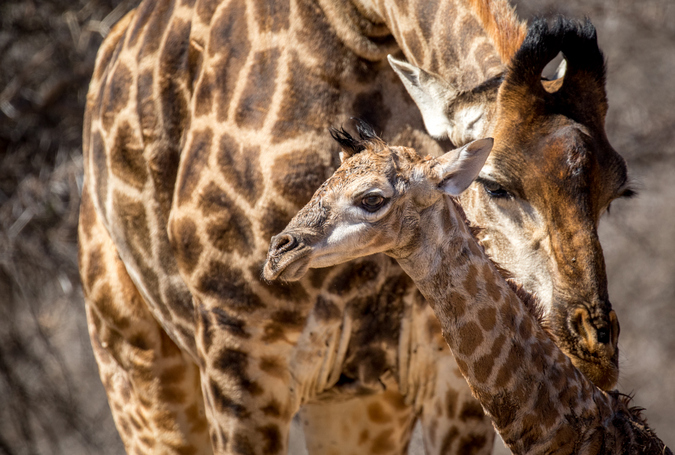
Written by Sophie Brown, photographs by Samuel Cox
The very nature of wildlife means you never know what may be around the corner. This was epitomised during a recent drive on a private game reserve.
It had been a relatively quiet drive when suddenly our guide stopped the vehicle and made a statement I never thought I would have the odds of hearing.
“There’s a giraffe giving birth.”
And sure enough, a brief look to the left showed that very sight.
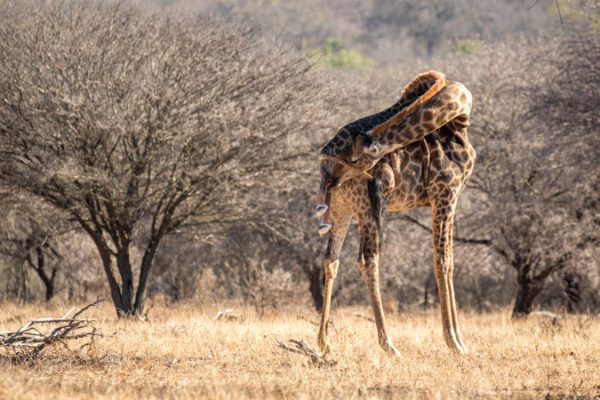
© Samuel Cox
In amongst the acacias, whilst making sure to be in an open area in order to sight potential predators, stood a lone female. Her waters had broken, amniotic fluid pooled on the ground next to her, the beginnings of legs protruding from her rear, fluid still dripping from its hooves.
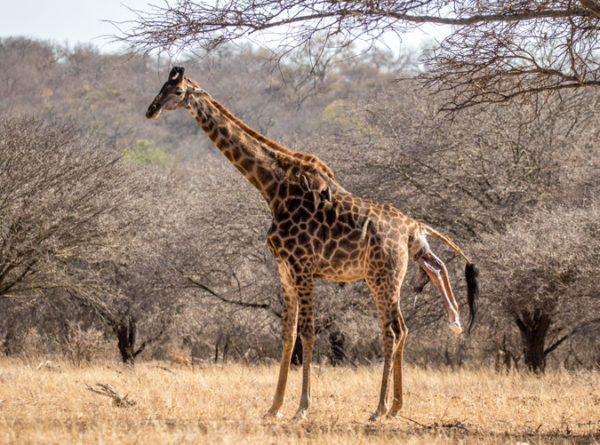
© Samuel Cox
With the vehicle positioned in the perfect spot and the engine turned off, we waited with baited breath to see how she would react to our presence.
Fortunately for us she seemed undisturbed and remained calm as we settled into our seats to watch something none of us ever thought we would be privileged enough to see.
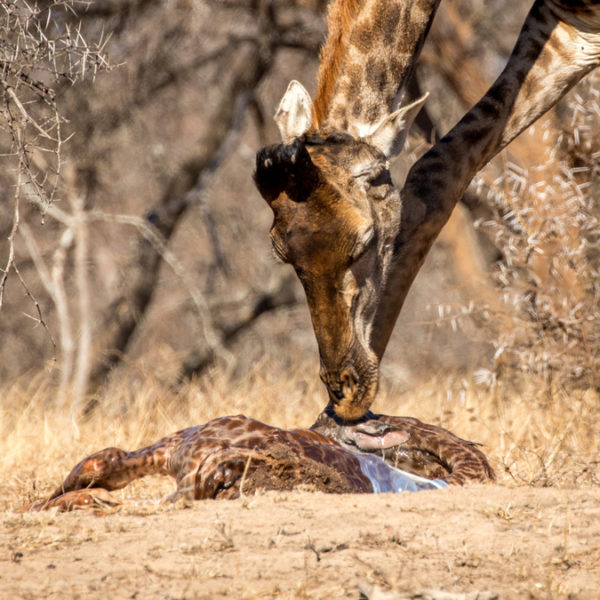
© Samuel Cox
Almost an hour passed and we watched as slowly, through intense strains from the mother, the remaining front legs and head emerged, a mucus plug remaining around its nose and mouth, sustaining its precious life during its arrival.
Then, as the neck slipped out and despite her acceptance of our presence, in a typical wildlife manner she retreated behind a termite mound, her giraffe instincts to hide kicking in. At this moment, the rear of the calf emerged and the newborn made its first contact with the earth, its back legs flailing out from behind the termite mound.
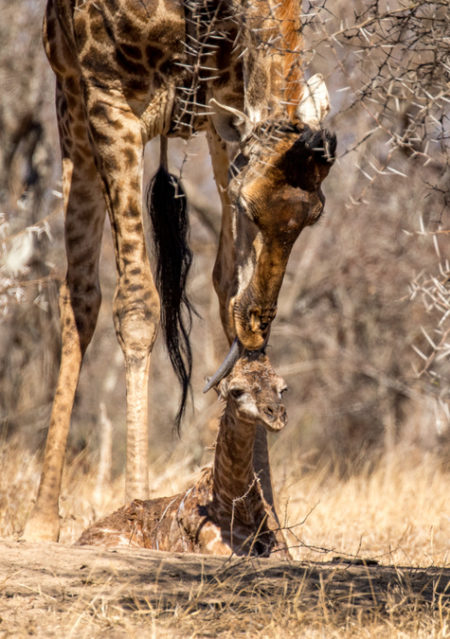
© Samuel Cox
As our vehicle was repositioned, our hearts were in our mouths as the calf stayed still on the ground for what felt like an agonising amount of time. In reality, it was perhaps only a couple of minutes but in that moment time stopped.
Then, a back leg kicked out and a tiny head swung up in an attempt to take up a seated position. Everybody breathed out a sigh of relief.
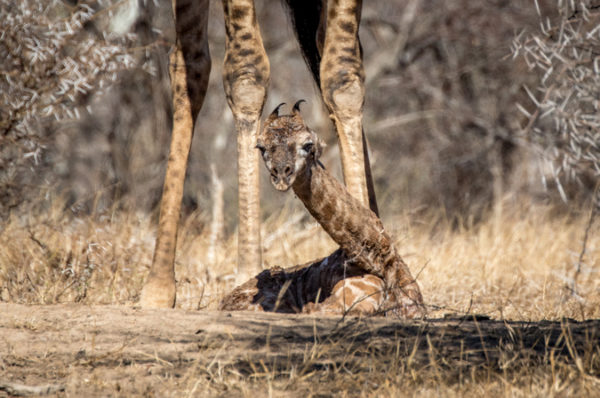
© Samuel Cox
But now came the next agonising wait. We all knew it was crucial that the calf stood as quickly as possible as in its current state it was in the most vulnerable position it would ever be in. Predators would take the opportunity to take down a newborn giraffe should there be any in the area.
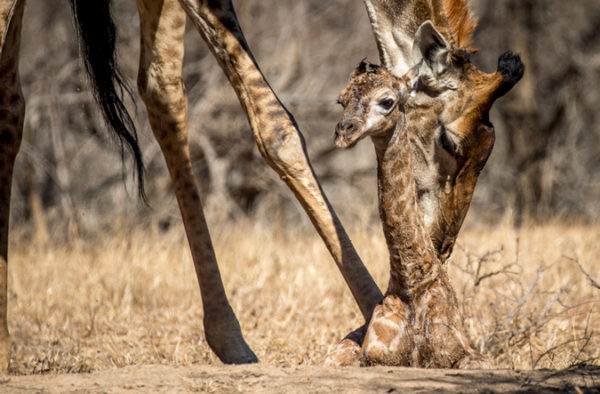
© Samuel Cox
Its mother was as aware of this as we were, and she quickly began licking the calf’s face, ears and neck in order to clean the amniotic sack still attached to the young.
She also began eating the placenta. By doing this, the mother removed the smells of the birth, giving the calf the best possible chance of survival in its first hours.
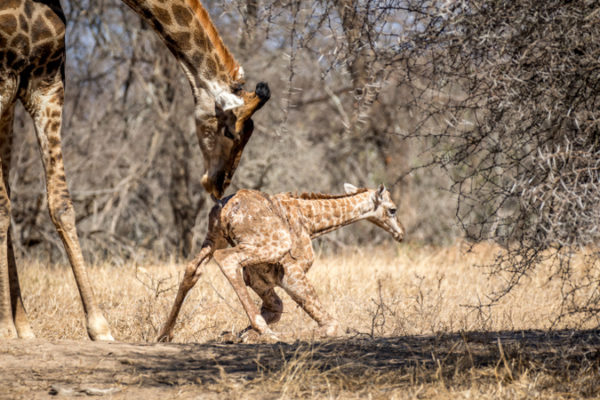
© Samuel Cox
We watched for an hour as the young calf made failed attempt after failed attempt to stand. With each minute that ticked by, the increasing risk of predator attack was forever on our minds. However, with each failure he inched closer to achieving his goal of standing.
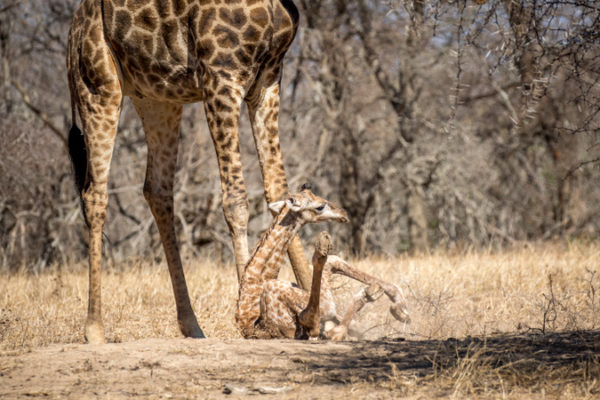
© Samuel Cox
Finally, with one mighty push, he staggered forward, rocking on his back legs, forcing his front legs up, standing for the first time in his short life.
Despite spending 15 months in his mother’s womb, developing his muscles, the baby trembled with the effort and energy it took him to maintain his standing position.
The sight was the most endearing sight I have ever seen, emotion filling the space as we all willed the calf to succeed in taking his first steps. As his mother began cleaning the remaining fluid from his body, he tentatively lifted his right hooves, replacing them a little further forward, followed tentatively by the left. He had accomplished his first steps. Pride overwhelmed us all.

© Samuel Cox
At this point, we left the new family to themselves, emotionally drained and adrenaline pumping.
When we stepped into the game drive vehicle as the sun began to rise that morning, we could never have expected to see such a sighting. The odds of seeing such a sight are truly once in a lifetime with many people never being able to claim seeing such an event.
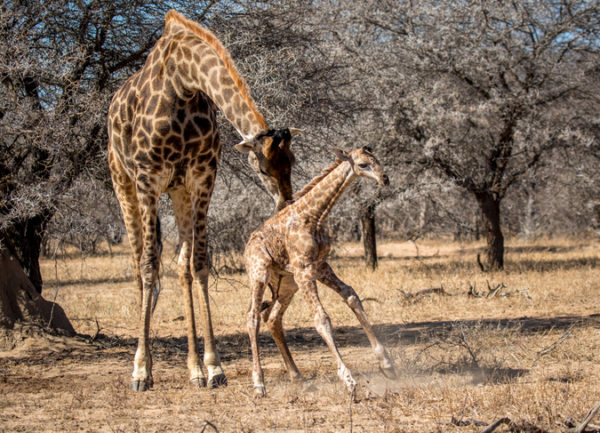
© Samuel Cox
It was an honour to watch as his mother expertly cared for her newborn in his first moments, magical to watch as he finally stood and heartwarming to witness his first steps. However, in the back of our minds was the overwhelming knowledge that he would have to continually defy the odds.
He had made it through his first moments of life but he will still have many obstacles to overcome if he is to beat the 50% chance of seeing his six-month birthday, let alone the course of his journey to fully fledged adult.
By the end of his first day he would be able to run, and within the next few days his mother would likely join a group of females and their young, and as a group they would work together to raise their young, giving them all the best possible chance of survival.
We hope that he will continue to defy the odds.
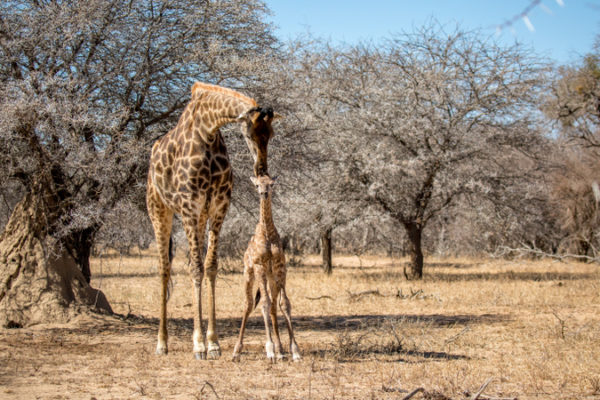
Wobbly newborn giraffe standing for the first time in its life
© Samuel Cox

Written by Sophie Brown, photographs by Samuel Cox
The very nature of wildlife means you never know what may be around the corner. This was epitomised during a recent drive on a private game reserve.
It had been a relatively quiet drive when suddenly our guide stopped the vehicle and made a statement I never thought I would have the odds of hearing.
“There’s a giraffe giving birth.”
And sure enough, a brief look to the left showed that very sight.

© Samuel Cox
In amongst the acacias, whilst making sure to be in an open area in order to sight potential predators, stood a lone female. Her waters had broken, amniotic fluid pooled on the ground next to her, the beginnings of legs protruding from her rear, fluid still dripping from its hooves.

© Samuel Cox
With the vehicle positioned in the perfect spot and the engine turned off, we waited with baited breath to see how she would react to our presence.
Fortunately for us she seemed undisturbed and remained calm as we settled into our seats to watch something none of us ever thought we would be privileged enough to see.

© Samuel Cox
Almost an hour passed and we watched as slowly, through intense strains from the mother, the remaining front legs and head emerged, a mucus plug remaining around its nose and mouth, sustaining its precious life during its arrival.
Then, as the neck slipped out and despite her acceptance of our presence, in a typical wildlife manner she retreated behind a termite mound, her giraffe instincts to hide kicking in. At this moment, the rear of the calf emerged and the newborn made its first contact with the earth, its back legs flailing out from behind the termite mound.

© Samuel Cox
As our vehicle was repositioned, our hearts were in our mouths as the calf stayed still on the ground for what felt like an agonising amount of time. In reality, it was perhaps only a couple of minutes but in that moment time stopped.
Then, a back leg kicked out and a tiny head swung up in an attempt to take up a seated position. Everybody breathed out a sigh of relief.

© Samuel Cox
But now came the next agonising wait. We all knew it was crucial that the calf stood as quickly as possible as in its current state it was in the most vulnerable position it would ever be in. Predators would take the opportunity to take down a newborn giraffe should there be any in the area.

© Samuel Cox
Its mother was as aware of this as we were, and she quickly began licking the calf’s face, ears and neck in order to clean the amniotic sack still attached to the young.
She also began eating the placenta. By doing this, the mother removed the smells of the birth, giving the calf the best possible chance of survival in its first hours.

© Samuel Cox
We watched for an hour as the young calf made failed attempt after failed attempt to stand. With each minute that ticked by, the increasing risk of predator attack was forever on our minds. However, with each failure he inched closer to achieving his goal of standing.

© Samuel Cox
Finally, with one mighty push, he staggered forward, rocking on his back legs, forcing his front legs up, standing for the first time in his short life.
Despite spending 15 months in his mother’s womb, developing his muscles, the baby trembled with the effort and energy it took him to maintain his standing position.
The sight was the most endearing sight I have ever seen, emotion filling the space as we all willed the calf to succeed in taking his first steps. As his mother began cleaning the remaining fluid from his body, he tentatively lifted his right hooves, replacing them a little further forward, followed tentatively by the left. He had accomplished his first steps. Pride overwhelmed us all.

© Samuel Cox
At this point, we left the new family to themselves, emotionally drained and adrenaline pumping.
When we stepped into the game drive vehicle as the sun began to rise that morning, we could never have expected to see such a sighting. The odds of seeing such a sight are truly once in a lifetime with many people never being able to claim seeing such an event.

© Samuel Cox
It was an honour to watch as his mother expertly cared for her newborn in his first moments, magical to watch as he finally stood and heartwarming to witness his first steps. However, in the back of our minds was the overwhelming knowledge that he would have to continually defy the odds.
He had made it through his first moments of life but he will still have many obstacles to overcome if he is to beat the 50% chance of seeing his six-month birthday, let alone the course of his journey to fully fledged adult.
By the end of his first day he would be able to run, and within the next few days his mother would likely join a group of females and their young, and as a group they would work together to raise their young, giving them all the best possible chance of survival.
We hope that he will continue to defy the odds.

Wobbly newborn giraffe standing for the first time in its life
© Samuel Cox
"Education is the most powerful weapon which you can use to change the world." Nelson Mandela
The desire for equality must never exceed the demands of knowledge
The desire for equality must never exceed the demands of knowledge
- Richprins
- Committee Member
- Posts: 75960
- Joined: Sat May 19, 2012 3:52 pm
- Location: NELSPRUIT
- Contact:
Re: Giraffe
Please check Needs Attention pre-booking: https://africawild-forum.com/viewtopic.php?f=322&t=596
- Lisbeth
- Site Admin
- Posts: 67384
- Joined: Sat May 19, 2012 12:31 pm
- Country: Switzerland
- Location: Lugano
- Contact:
Re: Giraffe
I could not copy the photos, but found them not exactly in the dark web, but almost
"Education is the most powerful weapon which you can use to change the world." Nelson Mandela
The desire for equality must never exceed the demands of knowledge
The desire for equality must never exceed the demands of knowledge
- Richprins
- Committee Member
- Posts: 75960
- Joined: Sat May 19, 2012 3:52 pm
- Location: NELSPRUIT
- Contact:
Re: Giraffe
You are the only member that I know of that has seen a live birth in Kruger! 
Please check Needs Attention pre-booking: https://africawild-forum.com/viewtopic.php?f=322&t=596


